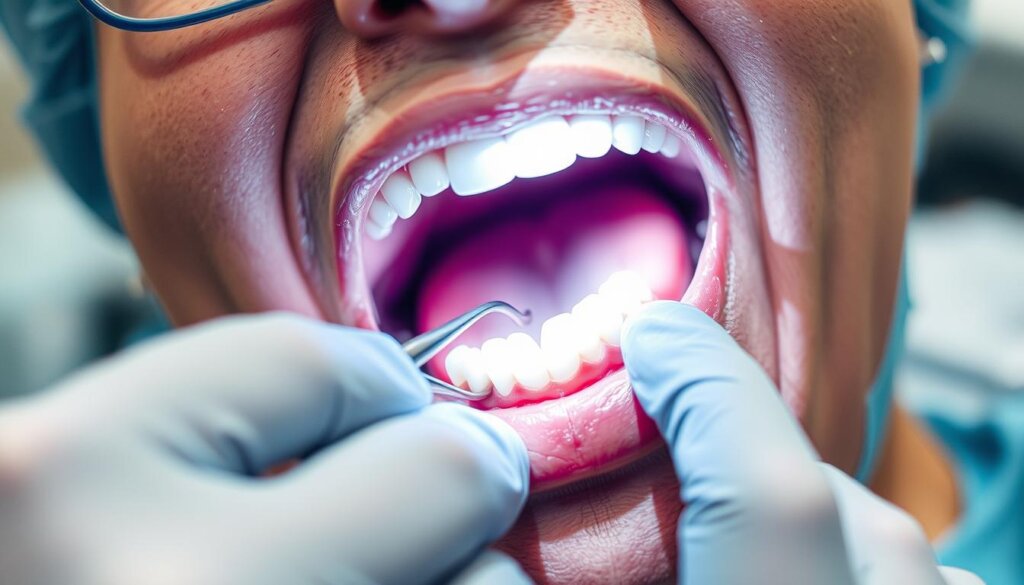What is a Dental Bridge, and How Does It Work?
About 120 million Americans are missing at least one tooth, showing a big need for solutions like dental bridges. Dental bridges are important for returning missing teeth, giving back a full smile. Basically, a dental bridge is like a bridge in your mouth. It spans the space where teeth are missing, bringing back function and looks.
A dental bridge is more than just for looks; it’s crucial for a good bite and jaw position. It’s made by creating fake teeth, called pontics, held in place by teeth on each side. This bridge not only fills in gaps but also helps with chewing and speaking. It fits in perfectly with the rest of your teeth, showing how dental skill and creativity come together.
In prosthodontics, dental bridges are key in bringing back oral health, combining strength with design to restore a healthy mouth’s key features.
Key Takeaways
- Dental bridges are a main way to fix missing teeth, helping around a third of Americans.
- They do more than look good, helping spread out the force when you bite and keeping teeth in place.
- Using a dental bridge to replace missing teeth stops other teeth from moving and keeps your face shape.
- Bridges are a less invasive option than implants, using neighboring teeth or implants for support, not replacing tooth roots.
- Building and placing a dental bridge well needs skill and careful planning, showing the importance of a dentist’s knowledge.
Introduction to Dental Bridges
Dental bridges are key in modern dentistry for replacing lost teeth. They offer a strong solution for dental restoration. This is crucial for those wanting to restore their smile.
Definition of a Dental Bridge
A dental bridge definition is a specially made prosthesis. It fills the space where teeth are missing. It is custom-made to connect natural teeth, anchored to the neighboring teeth or implants. The main part, called a pontic, is supported by crowns on the side teeth. This ensures the bridge looks natural and stays in place.
Importance of Dental Bridges in Dentistry
Dental bridges are essential for restoring smiles and improving chewing and speaking. They help maintain the shape of your face. They also prevent other teeth from moving, avoiding more dental problems. Bridges fit well with your existing teeth, boosting oral health and cleanliness.
Types of Dental Bridges
Looking into types of dental bridges is key for those wanting to fix their smiles. Each kind has its own perks and fits different dental needs.
Traditional Dental Bridges
The traditional bridge is very common. It has one or more fake teeth, called pontics. These are held in place by crowns on the teeth next to the empty space.
It needs strong, healthy teeth on both sides to hold the bridge.
Cantilever Dental Bridges
The cantilever bridge is different from the traditional one. It’s attached by a crown to just one tooth next to the gap.
It’s used when teeth are only on one side of the missing ones.
Maryland Dental Bridges
The Maryland bond uses a metal or porcelain frame. It sticks to the back of teeth next to the gap.
It keeps more of the original tooth because it needs less work on them.
Implant-Supported Bridges
Implant-supported bridges offer a stable choice. They use dental implants, not crowns, to hold the bridge.
An implant goes in for each missing tooth. Though this method takes more visits and costs more, it’s very durable.
Components of a Dental Bridge
Learning about the key parts of a dental bridge is key for anyone thinking of getting one to replace missing teeth. We’ll look into the main parts: abutment teeth, pontics, and other elements that make it work well and last long.
Abutment Teeth
Abutment teeth are crucial for a dental bridge’s structure. They are the real teeth next to the gap that get shaped to hold the bridge’s crowns. This shaping makes them strong anchors for the bridge, giving it stability and support.
Pontics
Pontics are the fake teeth that go into the gap of missing teeth. They are made from materials like porcelain to look and work like real teeth. This helps make the dental bridge blend with your natural teeth, improving your smile and bite.
Supporting Structures
The strength of a dental bridge comes from its supporting structures, which include:
- Metal Frameworks: These are mainly used in traditional and Maryland bridges for support and even force distribution while chewing.
- Porcelain Wings: Often used in Maryland bridges, these wings stick to the abutment teeth. This anchors the pontics without major changes to the abutment teeth.
- Dental Implants: For implant-supported bridges, these act as the strongest support. They are placed in the jawbone to act like roots for the missing teeth.
Every part has a critical role in the dental bridge components’ strength and how it works. This ensures people get back their dental health and confidence in their smiles.
The Process of Getting a Dental Bridge
Getting a dental bridge is a careful and detailed process. It involves several key steps to make sure your new bridge works well and lasts a long time. We will go through the process from the first visit to when the bridge is finally in place.
The first step is a dental bridge procedure assessment by your dentist. They check your oral health and specific dental needs. This check-up is vital to see if a dental bridge is right for you.
Next, the preparatory steps start. The teeth that will support the bridge are shaped. This is done so the dental crowns holding the bridge fit well and are comfortable.
Then, dental impressions are taken. These impressions help make a model of your teeth. The model is used by a dental lab to create a bridge that fits perfectly. A temporary bridge is usually placed to protect your teeth and keep your smile looking good.
The last step is fitting and adjusting the new bridge. Your dentist places the bridge, ensuring it fits well and feels right. They may make adjustments for the perfect bite and look. Once everything is perfect, the bridge is permanently fixed in place.
Every step in getting a dental bridge is important. It needs skilled dental work. Knowing these steps helps patients understand what to expect during their dental bridge process.
Benefits of Dental Bridges
Dental bridges do more than just fill empty spaces. They make smiles look better and help with oral health. This improves your overall well-being.
Dental bridges fix the complete structure of missing teeth. They spread out the force when you bite, making eating easier. They also make it easier to speak clearly.
Bridges improve how you look, which boosts confidence. They are made to look like your natural teeth, blending in perfectly.
They keep the natural shape of your face and stop teeth from moving out of place. This prevents future oral health problems. It keeps your facial structure and lowers the risk of teeth moving wrongly.
| Benefits | Impact on Oral Health | Impact on Aesthetics |
|---|---|---|
| Even distribution of bite forces | Improves chewing efficiency, reduces strain on other teeth | N/A |
| Prevention of teeth drifting | Prevents misalignment and related disorders | Preserves natural smile structure |
| Facial structure maintenance | Supports facial muscles and skin, preventing sagging | Keeps youthful facial contours intact |
Dental bridges help with function, looks, and oral health. They work together to keep your mouth and face healthy. This shows the advanced design behind dental bridges.
Challenges and Considerations
Dental bridges bring big benefits but come with their own set of dental bridge challenges. Knowing these challenges helps make the most of their function and bridge longevity.
Potential Complications
Dental bridges have some possible downsides. The teeth holding the bridge might get damaged or feel more sensitive. A bridge that doesn’t fit right could lead to decay, so watching out for problems and fixing them quickly is important.
Maintenance and Care
Taking good care of your bridge is key. It means cleaning your teeth well to stop plaque, which can cause gum disease and decay. Going for regular dental check-ups is also crucial for catching and dealing with problems early.
Longevity of Dental Bridges
How long a dental bridge lasts depends greatly on how well it’s cared for. They can last between 5 to 15 years, sometimes even more, with the right care. The material of the bridge, the health of nearby teeth, and good dental hygiene are all big factors in its life span.
| Factor | Impact on Bridge Longevity |
|---|---|
| Material Quality | Higher quality materials can enhance durability |
| Daily Hygiene Practices | Effective cleaning prolongs bridge function |
| Regular Dental Visits | Crucial for early detection and remedy of issues |
To get the best out of dental bridges, it’s essential to tackle dental bridge challenges, stick to good bridge maintenance, and know what affects bridge longevity. This way, patients can enjoy both the practical and cosmetic benefits of their bridges.
Who Needs a Dental Bridge?
Finding the right people for dental bridges is key in dentistry. These individuals usually have missing teeth and want a reliable fix. Dental bridges are great for those who can’t get dental implants, maybe because they don’t have enough bone or have health issues.
It’s also important to know how losing teeth can harm your mouth. Not filling in gaps can cause teeth to move, bite problems, and even make your jawbone weaker. So, it’s critical to take care of this early.
Choosing between dental bridges and implants depends on personal things like age, health of the mouth, and budget. Dental implants are like your own teeth and last a really long time, but bridges are less costly. They are easier to put in and don’t need as much follow-up.
People should talk to their dentists to figure out what’s best for them. Dentists will help them decide whether bridges or implants will work better for their situation.
Alternative Solutions to Dental Bridges
For those looking for dental bridge alternatives, many options are available. They depend on your health, needs, and what you prefer. These methods help make your teeth work better and look good using advanced dental practices.
Dentures and partial dentures are common choices instead of bridges. They work well for people missing several teeth in different places. Dentures improve how your teeth function and look.
Dental implants are a lasting fix. They replace lost teeth and also keep the jawbone healthy to stop it from getting weak. Getting dental implants involves a surgical step to secure them into the jawbone. They join with the bone over time, making a solid base for false teeth.
| Feature | Dentures | Partial Dentures | Dental Implants |
|---|---|---|---|
| Permanence | Removable | Removable | Permanent |
| Oral Health Impact | Low impact | Low impact | Aids in preserving jawbone |
| Suitability | Multiple missing teeth | Few missing teeth | One or more missing teeth |
| Cost | Lower | Variable | Higher |
Talking to a dental expert is key when thinking about dental bridge alternatives. They can give advice that fits your health history and dental needs. Your own preferences and how you expect it to affect your life should also help decide.
Cost of Dental Bridges
Knowing the dental bridge cost matters a lot if you need to replace missing teeth. The cost changes due to the materials used, how complex the work is, and how many teeth need replacing. Also, insurance coverage and financial considerations hugely affect how much you can pay.
Factors Influencing Price
Different things can change the price of a dental bridge a lot. What kind of bridge it is (like traditional, cantilever, Maryland, or implant-supported) and the materials (ceramic, porcelain, or gold) really matter. Where you live and how skilled your dentist is can also change the cost.
Insurance Coverage for Dental Bridges
Insurance can really help with the costs of dental bridges. Most dental insurance plans pay for some of the cost depending on the plan. This means you pay less yourself.
Financing Options Available
If you don’t have insurance or if it’s still expensive, many dental places let you pay over time. They offer plans to make payments easier over months or years. This help makes getting a dental bridge more doable.
| Type of Bridge | Typical Cost Range | Coverage by Insurance | Available Financing Options |
|---|---|---|---|
| Traditional | $2,000 – $5,000 | Up to 50% | Payment plans available |
| Cantilever | $2,000 – $6,000 | Up to 50% | Payment plans available |
| Maryland | $1,500 – $2,500 | Up to 40% | Payment plans available |
| Implant-Supported | $5,000 – $15,000 | Up to 50% | Payment plans available |
Maintaining a Dental Bridge
A dental bridge’s life and how well it works depend a lot on how you take care of it. We’ll talk about daily teeth cleaning, going to the dentist regularly, and spotting issues early. Doing these things helps keep your dental bridge in great shape.
Daily Care Tips
Good dental bridge maintenance starts with keeping your teeth clean every day. Here are some tips:
- Brush twice a day with fluoride toothpaste to keep plaque away from the bridge.
- Use a special brush or floss to clean under the bridge where food can get stuck.
- Rinse with a germ-killing mouthwash to fight off germs and stop gum disease.
Regular Dental Check-ups
It’s super important to keep seeing your dentist if you have a dental bridge. They can clean your teeth really well and check your bridge for any problems. Going for these check-ups helps with:
- Finding little problems before they get big.
- Making any needed adjustments to your bridge.
- Getting a deep clean that keeps your bridge strong.
Signs of Potential Issues
Knowing what signs might mean a problem with your dental bridge is key. Look out for:
- Feeling more sensitive or pain near the bridge.
- The bridge feeling loose or moving.
- Gums that are sore or bleed near the bridge.
Following these care tips can make your dental bridge last longer and keep your mouth healthy. Remember, good daily oral hygiene and regular dental check-ups are very important for taking care of your dental bridge maintenance.
The Role of Dental Professionals
A diverse group of dental professionals work together in making and keeping dental bridges good. Their skills cover many areas like making the bridge and giving customized care. Also, having regular check-ups is key to making sure dental bridges last and work well.
Dentists and dental technicians work hand-in-hand to design and fabricate dental bridges that are both functional and aesthetically pleasing.
Dentists’ Expertise in Fabrication
- Precision in crafting the bridge to fit snugly and match the patient’s natural teeth.
- Utilization of advanced materials and technology to ensure durability and comfort.
- Customization to accommodate individual oral health conditions and aesthetic desires.
Importance of Follow-up Visits
- Monitoring the bridge for any adjustments needed over time.
- Addressing any discomfort or complications that may arise post-procedure.
- Ensuring that the bridge functions correctly with the patient’s existing teeth and bite alignment.
Collaboration with Dental Technicians
- In-depth discussions on material choices and design specifics tailored to each case.
- Technicians providing valuable insights from their technical expertise to enhance bridge fabrication.
- Continuous communication throughout the process to ensure quality and precision in the final product.
The teamwork among dental professionals greatly improves the results of dental bridges. This connects technical abilities with caring for patients. Follow-up visits are very important, too. They let dentists make needed changes and provide care to keep the bridge working well.
Common Myths about Dental Bridges
Understanding dental bridges means knowing the truth from false stories. Sadly, many dental bridge myths are out there. They scare people away from getting them. Let’s explore the truth to debunk misconceptions and share accurate bridge information.
Some folks think dental bridges hurt, look fake, or won’t last. This isn’t true. By debunking these misconceptions, we aim to get rid of wrong ideas. This way, people can choose dental bridges knowing they’re a good option for their teeth.
| Myth | Reality |
|---|---|
| Dental bridges are painful to install | Modern procedures involve anesthesia, making the process virtually painless |
| Bridges look artificial and noticeable | Contemporary bridges are crafted to mimic natural teeth closely |
| Dental bridges don’t last long | With proper care, a dental bridge can last for over a decade |
By sharing accurate bridge information, we fight against common dental bridge myths. Our goal is to give patients the facts they need to feel good about their choices. It shows our dedication to better dental care and patient results. When patients know more, they see better results and feel happier about their decisions.
Conclusion: Making an Informed Decision
Dental bridges bring big benefits, improving how our mouths work, look, and feel. They help stop other teeth from moving and keep our face shape natural. A good look at dental bridges shows they’re great for fixing problems now and keeping mouths healthy in the future.
Choosing the right dental solution is key. Talk with a dentist to understand different bridges and their benefits. Dentists are crucial for a great experience with dental bridges. They offer personalized advice based on your dental health and needs. They’ll explain what to expect at every step.
Starting your journey to a better smile with a dental bridge involves careful talks and decisions. Working closely with your dentist is very important. This teamwork leads to the best smile outcomes. We urge patients to talk deeply with their dentists to make the best choice for their dental health.






